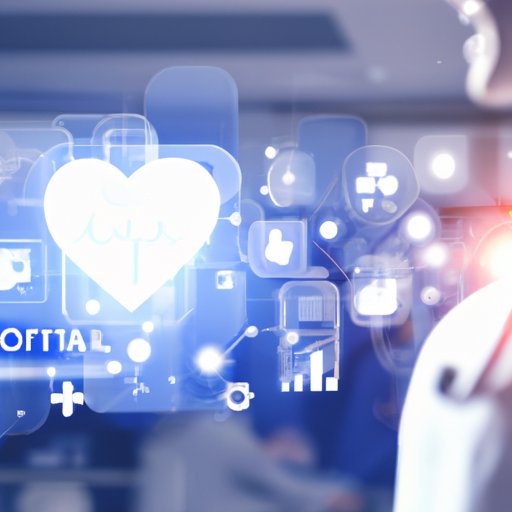Introduction
Patient care technologies have become essential tools in modern healthcare delivery. They are used to improve patient care, enhance communication between healthcare providers and patients, and increase accuracy and efficiency in healthcare delivery. This article will explore the various benefits of patient care technologies, the different types available, and how to select the right technology for your facility.

Exploring the Benefits of Patient Care Technologies
Patient care technologies provide a range of benefits that can help improve healthcare quality. These include improved patient care, enhanced communication between healthcare providers and patients, and increased accuracy and efficiency in healthcare delivery.
Improved Patient Care
Patient care technologies can be used to improve patient care by providing access to medical information, facilitating communication between healthcare providers and patients, and reducing errors. For example, electronic health records (EHRs) allow healthcare providers to access patient data quickly and easily, allowing them to make more informed decisions about diagnosis and treatment. Additionally, telemedicine can be used to facilitate remote patient consultations, reducing the need for in-person visits and allowing patients to receive care from the comfort of their homes.
Improved Communication Between Healthcare Providers and Patients
Patient care technologies can also be used to improve communication between healthcare providers and patients. For example, EHRs allow healthcare providers to share patient information with other healthcare providers, such as specialists, quickly and securely. Additionally, mobile applications can be used to facilitate communication between patients and their healthcare providers, allowing for more timely and convenient communication.
Enhanced Accuracy and Efficiency in Healthcare Delivery
Patient care technologies can also be used to improve accuracy and efficiency in healthcare delivery. For example, wearable medical devices can be used to monitor patient vitals, enabling healthcare providers to detect health problems early and intervene quickly. Additionally, robotic surgical systems can be used to reduce the risk of human error during surgery, improving safety and effectiveness.

An Overview of Patient Care Technologies
Patient care technologies come in a variety of forms, each offering unique benefits. Here is an overview of some of the most common types of patient care technologies:
Electronic Health Records (EHRs)
Electronic health records (EHRs) are digital versions of patient medical records. They enable healthcare providers to store, manage, and share patient data quickly and securely. EHRs also allow healthcare providers to track patient progress over time, helping them make more informed decisions about diagnosis and treatment.
Telemedicine
Telemedicine is the use of technology to facilitate remote patient consultations. It enables healthcare providers to connect with patients via video conferencing, phone calls, or text messaging, allowing for more timely and convenient communication. Telemedicine can also be used to diagnose and treat certain conditions, eliminating the need for in-person visits.
Wearable Medical Devices
Wearable medical devices are small, portable devices that can be worn on the body to monitor patient vital signs. They enable healthcare providers to detect health problems early and intervene quickly. Wearable medical devices can also be used to collect data that can be used to improve patient outcomes.
Robotic Surgical Systems
Robotic surgical systems are computer-controlled robotic arms used to perform surgeries. They enable surgeons to perform complex procedures with greater precision and accuracy than is possible with traditional surgical methods. Robotic surgical systems also reduce the risk of human error, helping to improve safety and effectiveness.
Artificial Intelligence
Artificial intelligence (AI) is the use of computer algorithms to simulate human intelligence. AI can be used to analyze large amounts of data to identify patterns and make predictions. In healthcare, AI can be used to diagnose and treat illness, develop personalized treatments, and improve patient outcomes.

How Patient Care Technologies Help Improve Healthcare Quality
Patient care technologies can help improve healthcare quality in a variety of ways. Here are some of the ways patient care technologies can help improve healthcare quality:
Improved Diagnosis and Treatment
Patient care technologies can be used to improve diagnosis and treatment by providing healthcare providers with access to accurate and up-to-date patient data. For example, EHRs can be used to track patient progress over time, helping healthcare providers make more informed decisions about diagnosis and treatment. Additionally, AI can be used to diagnose and treat illnesses, developing personalized treatments based on patient data.
Reduced Errors and Improved Safety
Patient care technologies can also be used to reduce errors and improve safety. For example, robotic surgical systems reduce the risk of human error during surgery, helping to improve safety and effectiveness. Additionally, wearable medical devices can be used to monitor patient vital signs, enabling healthcare providers to detect health problems early and intervene quickly.
Streamlined Processes and Cost Savings
Patient care technologies can also be used to streamline processes and reduce costs. For example, telemedicine can be used to facilitate remote patient consultations, reducing the need for in-person visits and resulting in cost savings. Additionally, EHRs can be used to store, manage, and share patient data quickly and securely, reducing paperwork and administrative costs.
Examining the Latest Trends in Patient Care Technologies
Patient care technologies are constantly evolving, and there are several emerging trends that are impacting the industry. Here are some of the latest trends in patient care technologies:
Increased Adoption of Cloud-Based Solutions
The use of cloud-based solutions is becoming increasingly popular in healthcare. Cloud-based solutions enable healthcare providers to store, manage, and share patient data quickly and securely. They also allow for scalability, making it easier to add new features and services as needed.
Growing Use of Mobile Applications
The use of mobile applications is also growing in popularity in healthcare. Mobile applications enable healthcare providers to communicate with patients and manage patient data on the go. They also allow patients to access their medical records, schedule appointments, and track their health from the convenience of their smartphones.
Expansion of Big Data Analytics
Big data analytics is becoming increasingly important in healthcare. Big data analytics allow healthcare providers to analyze large amounts of data to identify patterns and make predictions. This can be used to improve diagnosis and treatment, develop personalized treatments, and improve patient outcomes.
What Are The Different Types Of Patient Care Technologies?
Patient care technologies come in a variety of forms, each offering unique benefits. Here is a list of some of the different types of patient care technologies:
Clinical Decision Support Systems
Clinical decision support systems (CDSS) are computer-based systems designed to assist healthcare providers in making clinical decisions. They can be used to provide evidence-based recommendations, alert healthcare providers to potential drug interactions, and help ensure compliance with clinical guidelines.
Hospital Information Systems
Hospital information systems (HIS) are computer-based systems used to manage hospital operations. They can be used to track patient data, manage patient billing, and coordinate care across departments. HIS can also be used to monitor patient outcomes, helping to improve patient care.
Picture Archiving and Communication Systems
Picture archiving and communication systems (PACS) are computer-based systems used to store, manage, and share medical images. They enable healthcare providers to access patient data quickly and securely, helping to improve diagnosis and treatment.
Radiology Information Systems
Radiology information systems (RIS) are computer-based systems used to manage radiology data. They allow healthcare providers to store, manage, and share patient data quickly and securely. RIS can also be used to monitor patient progress, helping to improve patient care.
Laboratory Information Systems
Laboratory information systems (LIS) are computer-based systems used to manage laboratory data. They enable healthcare providers to store, manage, and share patient data quickly and securely. LIS can also be used to monitor patient progress, helping to improve patient care.
How To Select The Right Patient Care Technology For Your Facility
Selecting the right patient care technology for your facility can be a daunting task. Here are some tips to help you make an informed decision:
Identify Your Needs
Before selecting a patient care technology, it’s important to identify your needs. Consider the types of patient data you need to store, manage, and share, as well as the type of patient care you need to provide. This will help you narrow down your options and select the technology that best meets your needs.
Research Available Options
Once you’ve identified your needs, it’s time to research available options. Look for technologies that offer the features and functionality you need, as well as those that have a good reputation and are widely used in your industry. Don’t forget to read reviews and get feedback from other healthcare providers who have used the technology.
Consider Implementation Costs
When selecting a patient care technology, it’s important to consider implementation costs. Make sure you understand the costs associated with purchasing, installing, and maintaining the technology. Additionally, consider the costs associated with training staff on how to use the technology.
Evaluate Ease of Use
It’s also important to evaluate the ease of use of the technology. Make sure the technology is easy to use and understand, and that the user interface is intuitive. Additionally, consider whether the technology is compatible with existing systems and whether it offers any additional features or functionality.
Assess Scalability
When selecting a patient care technology, it’s important to assess its scalability. Make sure the technology can grow with your needs, and that it can accommodate an increasing number of users and data. Additionally, consider whether the technology can integrate with other systems and whether it can be upgraded or modified as needed.
Analyze Security Measures
Finally, it’s important to analyze the security measures of the technology. Make sure the technology offers adequate security measures to protect patient data, and that it complies with industry standards and regulations. Additionally, consider whether the technology offers encryption and other security features to help protect patient data.
Conclusion
Patient care technologies are essential tools in modern healthcare delivery. They can be used to improve patient care, enhance communication between healthcare providers and patients, and increase accuracy and efficiency in healthcare delivery. This article explored the various benefits of patient care technologies, the different types available, and how to select the right technology for your facility. By understanding the different types of patient care technologies and their benefits, you can make an informed decision when selecting the best technology for your healthcare organization.
(Note: Is this article not meeting your expectations? Do you have knowledge or insights to share? Unlock new opportunities and expand your reach by joining our authors team. Click Registration to join us and share your expertise with our readers.)
